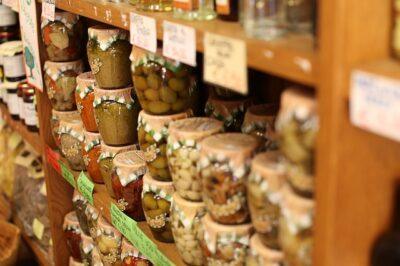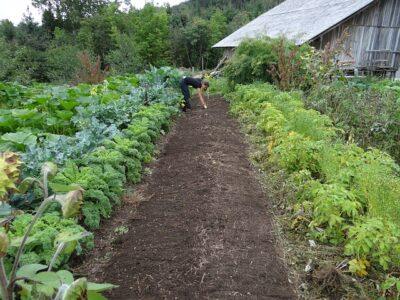One of the biggest questions facing anyone who is trying to prepare for disasters is that of time. How long will the crisis last? How long will it take for society to get back to normal? This question drives everyone’s stockpiling efforts — most especially, the decision about how much to stockpile.
What do we do if the disaster and its aftermath outlast our stockpile? Wouldn’t that normally put us in the same boat as all those people who didn’t bother to stockpile anything? Once our supplies run out, we’ll be faced with the same problems that they have. It might even be worse, because they will already have used up any available resources.
That’s why more and more people are turning to homesteading. By homesteading, we’ll theoretically be self-sustaining – not needing any outside help.
The real question is, whether we can truly make ourselves self-sustaining. If we go back in U.S. history, we find that our ancestors who settled the west were at the most about 95 percent self-sufficient. They all had needs for which they had to go to town sometimes. Unless we plan for the same things that they needed their local general store for, we could fulfill that little bit of poetry that says for want of a horseshoe nail, the war was lost.
So, what are these things and what can we do about it? Let me answer the second part of that first. The obvious answer is to either create systems which don’t need to be renewed with purchased parts or to stockpile enough to last us the rest of our lives.
Your Garden
The first thing that most of us think of when we think of making ourselves self-sufficient is gardening. A good vegetable garden will go a long way toward providing us with something to eat. We’ve all seen stories about people who fed their families entirely off of what they grew in their backyards and we’re sure that we can do the same.
The Best Source For Non-GMO Heirloom Seeds Is Right Here …
Heirloom seeds are the basic building block of that gardening. But did you know that seeds have a shelf life? The longer you keep them, the lower the germination rate. The solution to that is to use the seeds and harvest seeds from what you grow. That will give you an ongoing supply of fresh seeds.
Of course, we need more than just seeds to grow a garden. We need good soil, some way of keeping the pests under control, and water. I like keeping my garden as natural as possible, using carnivorous insects like lady bugs and the praying mantis to keep destructive bugs under control. My favorite fertilizer is a fish emulsion and I compost. By doing these things, I eliminate the need to buy fertilizers and other chemicals.
Raising animal protein is a little more complicated. We have to provide the animals with something to eat. That means either growing enough food for them or buying feed. Unless you have a lot of land to work with, it seems to me that the only livestock that is practical to raise is something that can be fed off the scraps of what you can grow in your garden, such as rabbits and chickens.
Canning Supplies
Then there’s the need to do something with all that great food you grow. As we all know, unless you live in a really warm climate, you’re not going to be growing much in the dead of winter. So, you’ll need to preserve the food. But are you prepared for several years of preserving food?
Fortunately, canning jars are reusable. But the lids for them are not, at least not usually. Some survivalists have done some experimenting and have succeeded in reusing their lids, but even if you succeed, how many times can you reuse them? That’s one of those items that you will need a mountain of, to last you through the years.
Here’s another item that few people think of – salt. Back in the pioneering days, there were still salt licks that animals used. Pioneers also would go to those salt licks and harvest salt for their use. I seriously doubt there are any left today, as most of our salt is mined underground. So what are you going to use for salt to cure or smoke meat and for your canning? Better stock up now, while you have a chance.
Woodcutting
That pile of firewood you have in the backyard is hopefully going to be enough to get you through the winter. But what are you going to do next year? Do you have the capacity to cut and haul enough wood to heat your home for another year? Can you do that without gasoline?
Cutting firewood with a chainsaw and hauling it with a truck is bad enough. What about when you have to cut it with an axe and a saw? Do you have the tools for that? Do you have something you can haul it with that doesn’t require a gasoline engine? Unfortunately, few of us have horses so we won’t have their strength to help us.
Getting the right tools, along with a means to haul the cut wood, needs to be somewhere on your sustainability list. Otherwise, you’re going to face some really cold winters.
First-aid and Medicine
Few of us have the capability to do much about making our own first-aid supplies. Granted, any cloth can be used as a bandage, but that’s about as far as we can go. Medicines are even worse. And there’s no real way of knowing what you’re going to need, just that you’re going to need something.
Discover How To Make Just About Anything … From Scratch!
I’m not sure it’s possible to stockpile enough medicine and first-aid supplies to last, but somehow we’ve got to try. At the same time, we should look for options which will allow us to get by without those supplies. Fortunately there are things in nature that will help our medical efforts.
Herbal medicine has existed far longer than modern medicine. In many ways, modern medicine is merely an offshoot of herbal. Many modern medicines are simply artificial synthesis of naturally occurring chemicals. Learning how to go back to nature on this, can give us the needed medicines when they aren’t available.
Sewing
We’re so used to going to the store and buying clothes that few of us even think about making them anymore. Yet if we have growing children, we should be thinking about it. Granted, there will be clothing available for barter, at least for a while, but what about after that? Then what?
Making natural fibers into thread or yarn to make fabric and then turning that fabric into clothing is a long process, requiring special equipment and knowledge. But if the supply chain collapses and stays that way, that may be the only way of keeping ourselves and especially our children in clothes.
Spares for Critical Systems
The last item I want to mention is also the simplest on this list. That is to have spares for all your critical systems. What do I mean by critical systems? I mean anything and everything you need to have in order to survive, especially if it won’t be available in that time.
There are plenty of things we all have included in our survival strategy which are modern-day tools for survival. Take solar power, for example. That’s a great aid, allowing us to use at least some of our modern-day electronics. But what happens to your solar power system if it’s hit by an electromagnetic pulse (EMP)?
Supposedly, the panels themselves will survive, although their efficiency will be reduced by about 10 percent. But that’s not the big issue. That power won’t do a bit of good if your charge controller and your voltage inverter are dead. You better have spares stashed away in a Faraday Cage if you are expecting to use solar power after an EMP.
What Else?
Obviously this list isn’t complete. I give you these ideas more to get you thinking than for any other reason. If you’re just starting out, get your basic stockpile of supplies in place first before starting on this. As you’re doing so, start thinking about long-term sustainability. How can you roll over from living off your stockpile to living in a self-sufficient way?
Take a look at each and every area of your survival plans. Do you have a sustainability plan for that item? If not, what can you do to make a change, making it possible to live many years past what your supplies will last?
What would you add to this list? Share your ideas in the section below:
Discover The Secret To Saving Thousands At The Grocery Store. Read More Here.
 Off The Grid News Better Ideas For Off The Grid Living
Off The Grid News Better Ideas For Off The Grid Living






